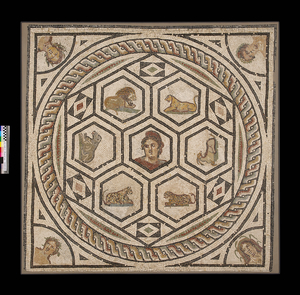Roman Mosaics Across the Empire
Getty Villa / March 30 – September 12, 2016
***
We live in an age of globalization, in which a common culture is shared in many geographical locations while local identities are maintained. The Getty Villa’s current exhibition, Roman Mosaics Across the Empire, testifies to a similarity experienced nearly two thousand years ago throughout the Mediterranean basin and sections of the European continent. On view are mosaics from Italy, France, Tunisia and Syria. This exhibition, drawn mostly from the Getty Villa’s collections, will be on view through September 12, 2016. It provides visitors with both an aesthetic experience and an assessment of the role and significance of mosaics in the Roman Empire’s history during period of 150 – 400 AD.
Used primarily as flooring in the huge public baths and in the individual residences of the affluent, their function was primarily decorative/utilitarian. They were also to be found on walls in temples and theaters. Ancient Roman mosaics could be divided into two principal categories: geometric patterns and those illustrating various aspects of mythology, religion, athletics, and everyday life. Without question, they dignified and enhanced the ambiance of the physical spaces in which they were utilized.
As at The Getty, when flooring fragments are displayed vertically on the walls of a museum gallery, their aesthetic appeal is enhanced. Some of the mosaics in this exhibition, too large for wall display, can be viewed as they would have been seen at the time of their creation —as flooring.
Like so much of Ancient Roman culture, mosaics owe a debt to Ancient Greece. There, mosaics were constructed of naturally formed and colored stones.
The use of tesserae (cut stone cubes) became prevalent as a consequence Alexander The Great’s conquests. By 200 B.C. Romans were creating mosaics of limestone and marble cut into small cubes. Later, the Romans incorporated glass. Some of the most spectacular mosaics incorporating stone, glass and gold leaf were created at a later time in the Byzantine era.




